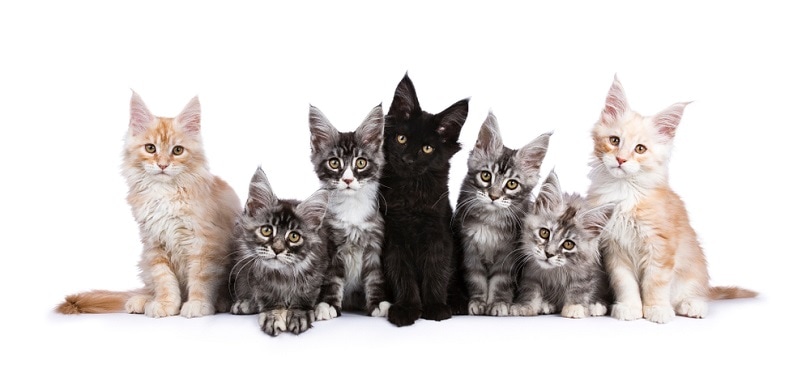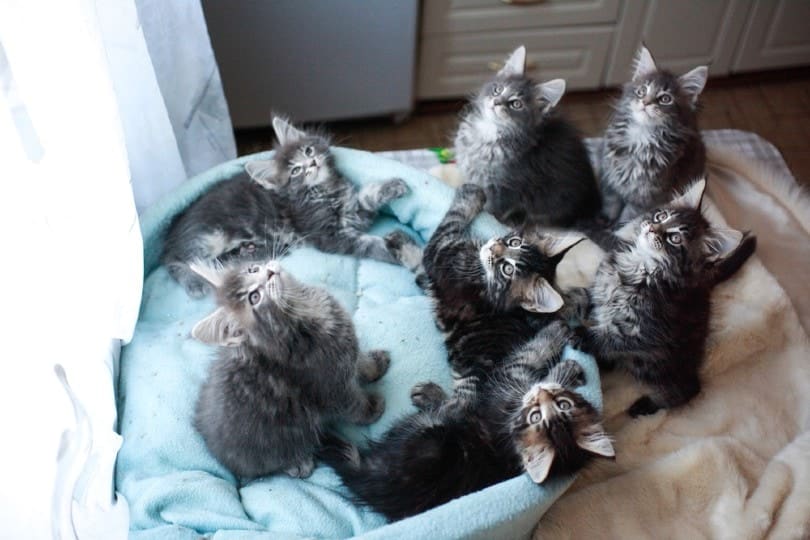Catster advocates for adopting before shopping, though we fully understand there are many reasons for seeking a breeder. So, we encourage it to be done the right way. We have not personally visited or investigated all of the breeders below. We have put the top-recommended all in one place for you to get in touch and make the best decision for you. Learn more about our stance and how to choose the right breeder here.
The Maine Coon cat is one of the largest cat breeds globally and is native to the United States. Their long fur and friendly nature make them extremely popular amongst children and adults, and they even get along with other pets and strangers, so it’s no wonder so many people are looking for breeders.
If you would like to get a Maine Coon for your home but aren’t sure where to purchase one, keep reading while we look at where to find breeders in the United States, how much they cost, and some other important things you should know to help you make an informed decision.
Maine Coon Breeders in the US
Choosing a good breeder is an essential part of acquiring your Maine Coon kitten. A high-quality breeder is likelier to produce a healthy cat that will live longer and spend less time at the vet. These breeders are also more likely to keep the parents in a suitable environment and not mistreat them.
The International Cat Association – A large list of Maine Coon breeders around the world, including several in the United States.
Maine Coon Kittens for sale near you – List of Maine Coon breeders by state.
Breeders that ship – If you need your Maine coon delivered to you, there are several you can choose from, including Purebred Main Coons, and NW Coonies.

How Much Does a Maine Coone Kitten Cost?
We recommend setting aside between $650 and $2,000 for your Maine Coon kitten. Several factors will affect your price, including the breeder you choose, your distance from the breeder, and the sex, color, size, and quality of the kitten.
A show-quality cat with breeding rights is the most expensive, and an ordinary “pet-quality” kitten is the cheapest. However, you will need to get the less expensive cat spayed or neutered, which will add to the overall cost.
We also recommend thinking beyond the price of the kitten. You will also need to purchase a litter box or two, food and water bowls, a cat carrier, regular check-ups at the vet, flea and tick medication, food, litter, and more. While not expensive, it’s an ongoing expense that can eat into your budget if you don’t plan for them.
Things to Ask a Maine Coon Breeder
Unfortunately, many people purchase their cats online in a shopping format, which is convenient but forfeits the chance to ask the breeder several questions that can be helpful for which breeder to use. These questions can also help you learn more about your cat and what you can expect as it gets older.
Are the Parents Certified?
Breeders can have the parents of your kitten certified to be free of certain genetic diseases, including cardiovascular disorders, physical disorders like hip dysplasia and patellar luxation, neurological disorders, and more.
Can I Meet the Parents?
Meeting the parents is a great way to learn about your kitten. They will look like the parents and have a similar temperament, so try to spend as much time with them as you can.
Are the Kittens Socialized?
Kittens that spend a lot of time with other kittens for their first few weeks tend to get along with other cats and pets much better. Socialized cats are also more outgoing.

Has the Kitten had Any Vaccinations?
Kittens require several vaccinations, including distemper and rabies. If they don’t get them from the breeder, you will need to get them from the vet, so it’s important to ask which vaccinations the cat had and when the next ones are due.
Were Any of the Kittens In The Litter Sick?
Illness can easily travel to other kittens, so it’s essential to know if any of the kittens were sick and which treatment they received.
Is There a Health Guarantee?
The best breeders will guarantee their kittens are free of genetic disorders that can cause expensive health problems. Knowing if a breeder offers a guarantee and how they will honor it if the cat gets sick is important.
Is There a Contract?
If there is a contract, we recommend reading it carefully until you understand all the terms, including which conditions the breeder will take the cat back.

What Is the Family History?
Learning about the family history of your kitten is as important as meeting the parents. The history can give you an idea of how long your cat will live, what they usually die from, and when certain genetic conditions were last seen.
Will You Receive a Health Certificate?
If your breeder is certified, you will likely get a health certificate stating that the cat is free from common genetic disorders.
Is the Breeder Part of a Breed Club?
Breeders that are part of a breed club are more likely to follow the standard for your Maine Coon, which will result in a healthier cat. Breeders will not likely risk their membership by mistreating the animals or producing unhealthy cats that don’t follow the standard.
The 6 Things to Know Before Buying a Maine Coon
- The Maine Coon has a long thick double coat that will protect them from extreme temperatures but can be a pain to maintain. You must brush the coat every few days to keep it tangle-free.
- The Maine Coon doesn’t shed more than other cats, but since they are so large and have long, thick fur, you can end up with quite a bit of hair in your home.
- Due to their large size, you can expect them to eat significantly more than other breeds.
- It can be challenging to find a litter box for your Maine Coon, and many owners choose to use large, lined cardboard boxes as disposable litter boxes to provide enough room for the cat to turn around while using it when they are fully grown.
- Maine Coon cats like to snuggle and will spend a lot of time on you while you sleep and watch television.
- Maine Coon cats like to sit on perches, so you will need several high places in your home large enough to hold them. Otherwise, they will sit on the backs of furniture, counters, tables, and beds.
Conclusion
The Maine Coon makes a fantastic pet. Their huge, lovable size often causes owners to describe it as a gentle giant, and you can usually find one for less than $1,000 if you are not looking to become a breeder or enter it into cat shows. If you are purchasing from an online breeder, ensure you read the entire website, especially the reviews and comments. If you are purchasing from a local breeder, remember the list of questions so you can learn as much as you can about your cat before buying one.
We hope you enjoyed reading this guide and found the answers you need. If we have helped you find your next pet, please share this guide to finding breeders in the US on Facebook and Twitter.
Featured Image Credit: Nils Jacobi, Shutterstock
Contents
- Maine Coon Breeders in the US
- How Much Does a Maine Coone Kitten Cost?
- Things to Ask a Maine Coon Breeder
- Are the Parents Certified?
- Can I Meet the Parents?
- Are the Kittens Socialized?
- Has the Kitten had Any Vaccinations?
- Were Any of the Kittens In The Litter Sick?
- Is There a Health Guarantee?
- Is There a Contract?
- What Is the Family History?
- Will You Receive a Health Certificate?
- Is the Breeder Part of a Breed Club?
- The 6 Things to Know Before Buying a Maine Coon
- Conclusion













